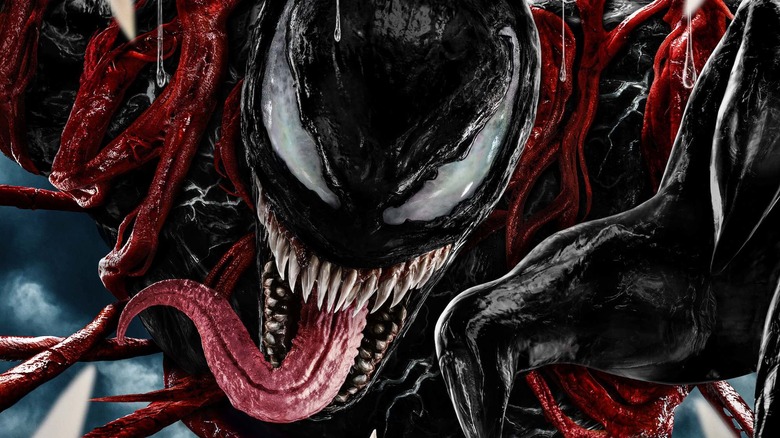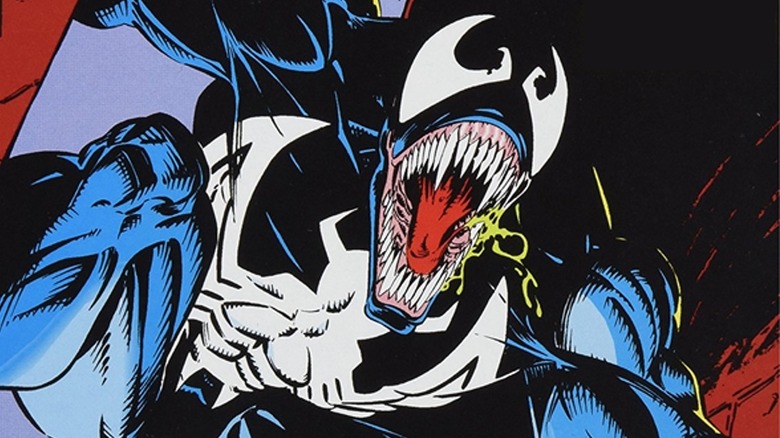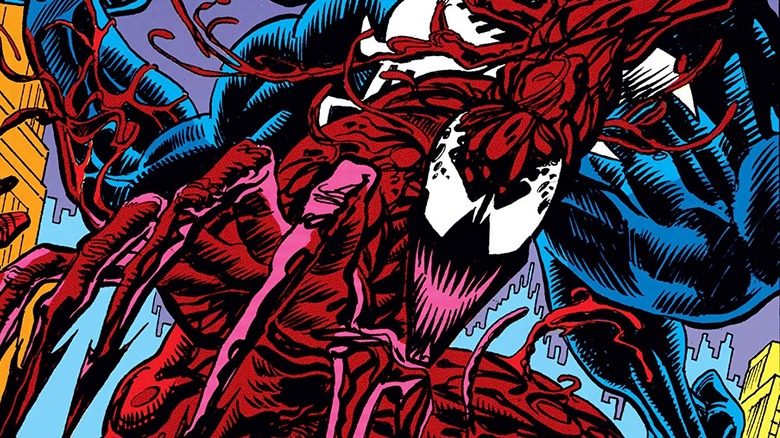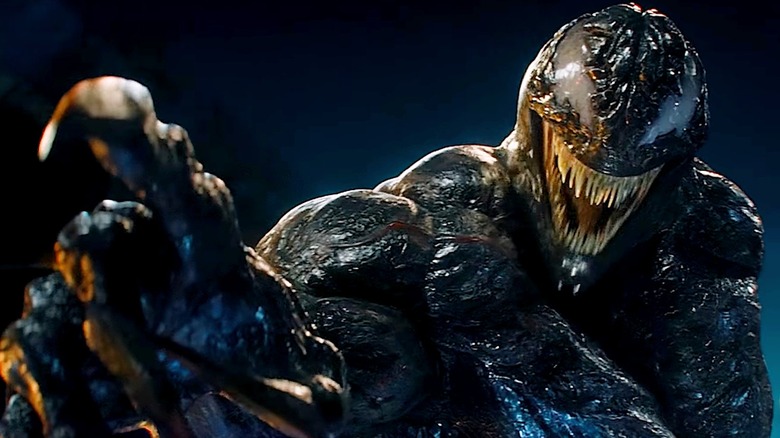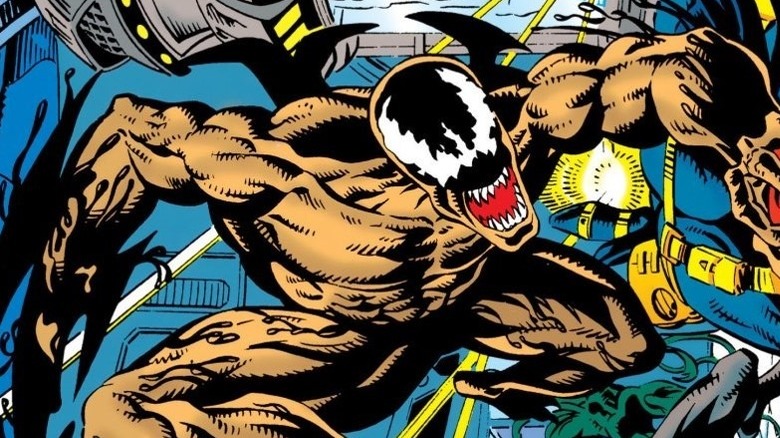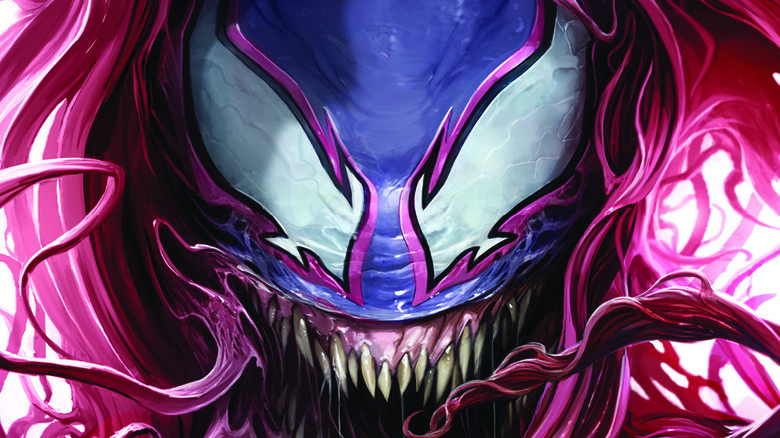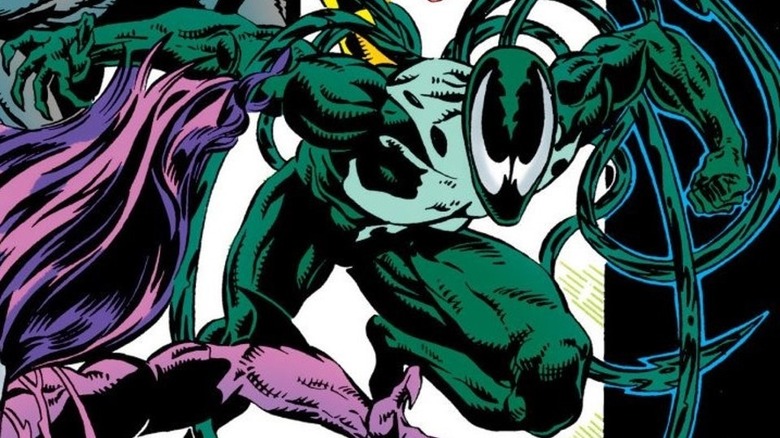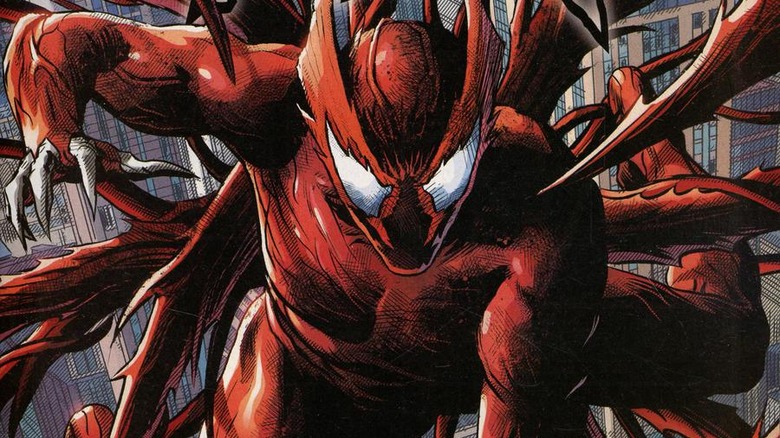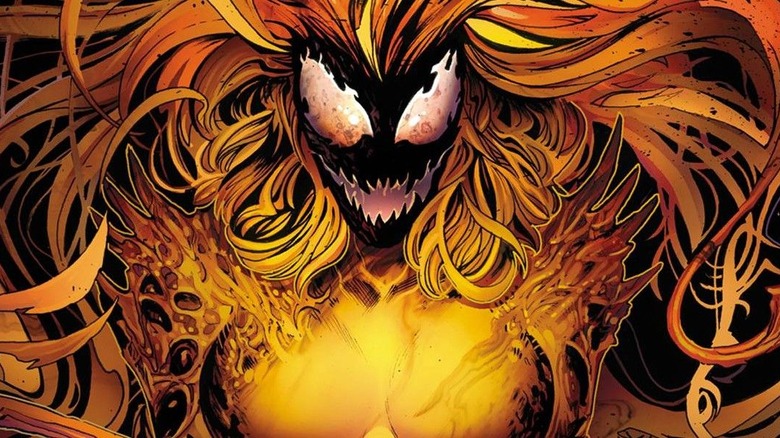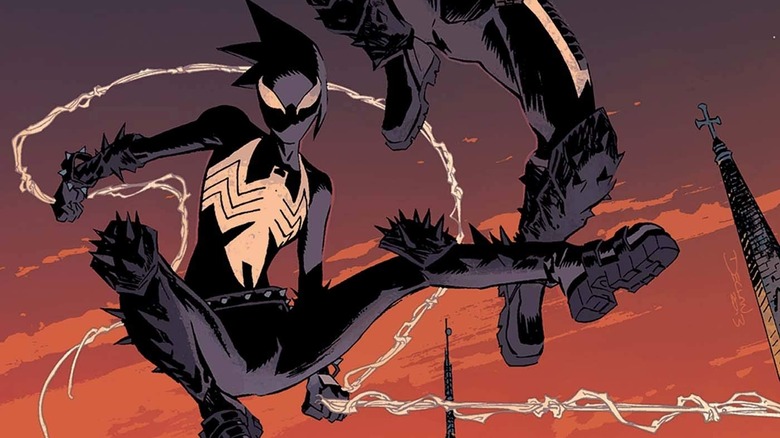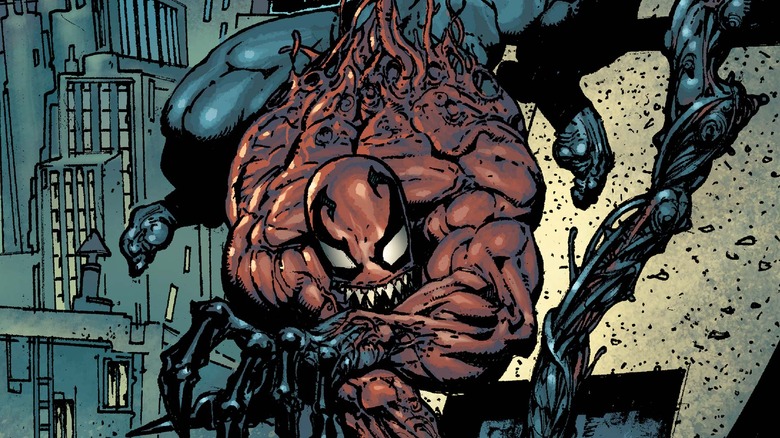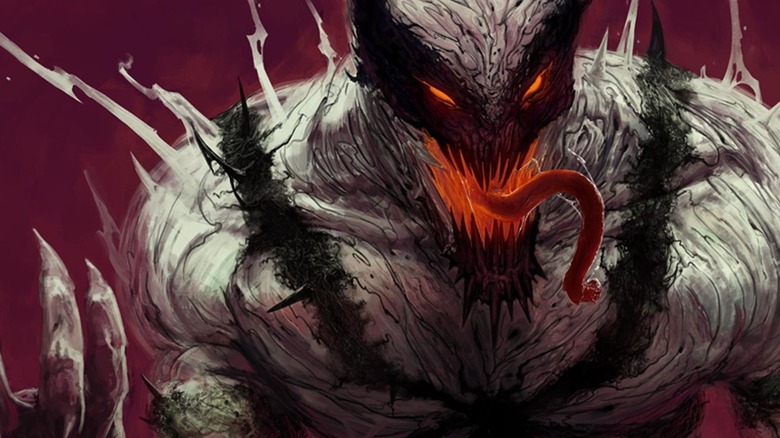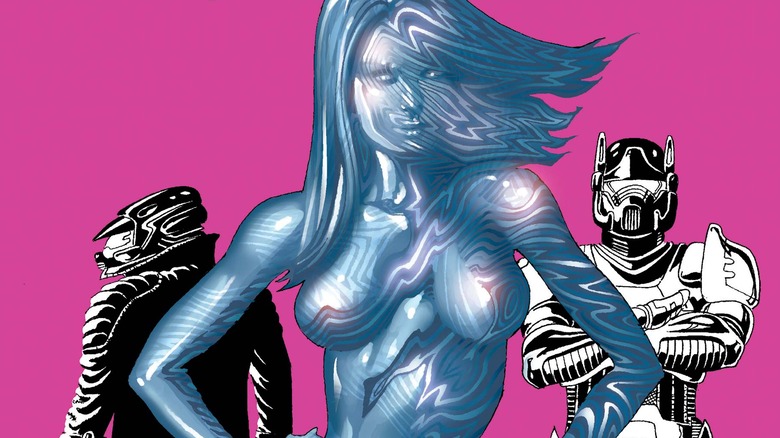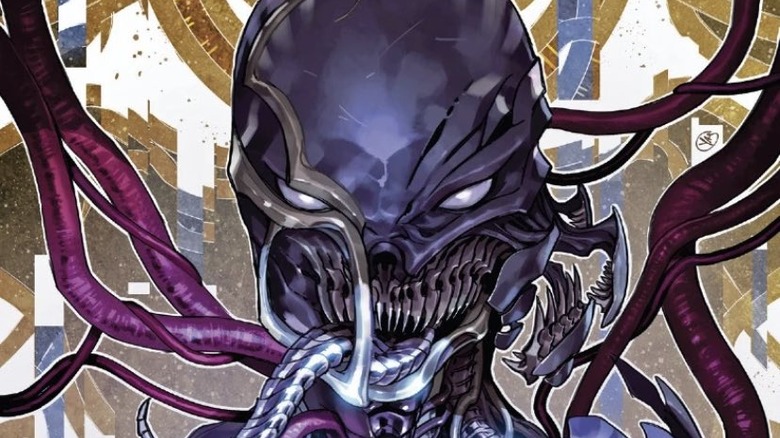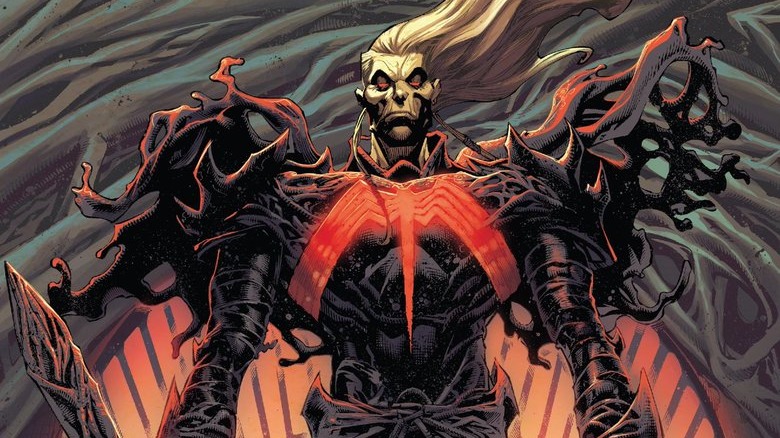Every Major Symbiote In Marvel Explained
When Tom DeFalco, Ron Frenz, and Roger Stern decided to give Spider-Man a brand-new costume in "Amazing Spider-Man" #252 in 1984, they had no way of knowing this new costume would lead to so much more. 40 years later, that new costume has become a franchise unto itself, giving birth to two of Spider-Man's greatest villains, numerous comic book series, countless spin-off characters, and a series of movie theater blockbusters.
Though still ostensibly Spider-Man characters, symbiotes like Venom and Carnage have become successful icons in their own right, something that 2018's "Venom" and its $820+ million box office proved to great effect. To paraphrase Uncle Ben: With great success comes great potential for spin-offs.
Just as Spider-Man gave birth to Venom, Venom has given birth to a vast cast of bizarre symbiote-related characters. Since the sheer volume of symbiotes in the Marvel Universe can easily overwhelm new fans, here's a breakdown of the most important symbiotes that superhero fans need to know.
Venom
Trapped on another world, Spider-Man used an alien machine in "Marvel Super Heroes Secret Wars" #8 to obtain a new, black-and-white costume. After he returned to earth, however, he discovered in "Amazing Spider-Man" #258 that the new "outfit" was actually a living, alien, symbiotic organism that was vulnerable to fire and intense sound.
Distraught, Peter used the loud bell tower of a cathedral to divorce himself from the symbiote in "Web of Spider-Man" #1, but in doing so, he hand-delivered the symbiote to a man who would become one of his greatest enemies: Eddie Brock.
First introduced in "Web of Spider-Man" #18, Eddie was a newspaper reporter who was blacklisted when Spider-Man debunked his claims about a local serial killer. When Peter rejected the symbiote at the church tower, Eddie was praying below, and the symbiote dropped down and bonded with Brock in "Amazing Spider-Man" #300. Their mutual hatred for Peter united them, and they became Venom.
Despite becoming an anti-hero in recent years, Venom was one of Spider-Man's most dangerous foes. The symbiote had copied Spider-Man's powers during their time together, granting Eddie all of the Web-Slinger's abilities and more. He was faster and stronger, could create tendrils to be used as weapons, camouflage into his surroundings, and was immune to Spider-Man's famous "spider sense." Though others have bonded with the symbiote to become Venom, Eddie Brock is still the most famous version of the villain by far and was chosen for the 2018 film because of this.
Topher Grace was the first to portray a live action Eddie Brock/Venom in 2007's "Spider-Man 3," although it's safe to assume most fans prefer the Tom Hardy incarnation in "Venom" and the upcoming "Venom: Let There Be Carnage."
Carnage
When Eddie Brock and the Venom symbiote were defeated and temporarily separated, Eddie was imprisoned alongside a notorious serial killer named Cletus Kasady. The two did not get along, and when the Venom symbiote finally came back for Eddie, it asexually reproduced and spawned a new symbiote that bonded with Kasady at a cellular level, creating a new villain named Carnage in "Amazing Spider-Man" #345.
Every time a symbiote reproduces, its offspring is more powerful than its forebear, and thus, Carnage proved far deadlier than his venomous father.
Carnage possesses all the powers of Venom, but is stronger, faster, and more durable. Unlike Venom, Carnage can turn his symbiote into weapons like blades, axes, and sickles. Additionally, because Kasady and Carnage are bonded at a cellular level, they cannot be separated like Venom and his many hosts, as Kasady can simply reform Carnage at will (as revealed in 1993's "Spider-Man Unlimited" #1).
With his newfound powers, Carnage easily escaped from prison and began a new killing spree that was only stopped when Venom and Spider-Man teamed up to finally defeat him in "Amazing Spider-Man" #362 and 363. Since then, Carnage has returned time and time again to terrorize the planet, often requiring entire teams of heroes to stop him.
With Woody Harrelson portraying Cletus Kasady in the upcoming "Venom: Let There Be Carnage," it seems this symbiote is finally ready for his cinematic close-up.
Riot
Before 2018, Riot was one of the most obscure symbiotes in the Marvel Universe. In fact, he didn't even get a name until "Carnage, U.S.A." #2 in 2012, nearly a decade after his introduction in 1993's "Venom: Lethal Protector" #4, but that all changed when Sony Pictures decided to use Riot as the central antagonist in 2018's "Venom" movie.
With that appearance, Riot skyrocketed up the symbiote charts, though the movie did take some liberties with the character's backstory. In the film, Riot is the leader of an advance party sent to earth by the Kyntar species in order to prepare for the symbiotes' invasion. He bonded with Riz Ahmed's Carlton Drake, the head of the sinister Life Foundation, and convinced the man to help bring the rest of the symbiotes to earth until Venom managed to stop them both.
In the comics, however, Riot was something entirely different. Though still tied to the Life Foundation, the symbiote wasn't a separate individual but instead another of Venom's many offspring. Riot and four others — Phage, Agony, Lasher, and Scream — were all created by experimenting on the Venom symbiote and forcing it to asexually reproduce five more times. Unlike some of his siblings, Riot rarely operated alone and was almost always seen alongside his siblings.
Phage
Introduced in "Amazing Spider-Man" #298, the Life Foundation was created to ensure the richest and most powerful people on earth could survive the predicted nuclear fallout of the Cold War by sheltering in their own personal utopia. To that end, they sought out creatures that could survive such a world and eventually decided to use the Klyntar.
Collectively referred to as the "Life Foundation Symbiotes," Riot, Phage, Agony, Lasher, and Scream were all artificially created from the original Venom symbiote after managing to briefly capture the villain in "Venom: Lethal Protector" #3 and 4. Despite this, Phage and his siblings each possessed unique abilities that set them apart. Where Riot seemed to be the strongest and could create hammers and maces to fight his battles, Phage would form sharp, bladed weapons in order to eviscerate his foes.
Phage initially bonded with Carl Mach, an officer of the Life Foundation's private security force, and when Venom finally escaped his imprisonment, Phage and his siblings were sent to recapture him. Venom teamed up with Spider-Man to fight the Life Foundation Symbiotes, and even though they were badly outnumbered, the duo emerged victorious when Venom managed to use a device that seemingly aged each of the five symbiotes to dust in "Venom: Lethal Protector" #5.
Agony
Originally bonded with Security Officer Leslie Gesneria, Agony was unique among her Life Foundation siblings due to her ability to deconstruct and create chemical compounds, allowing her to dissolve Spider-Man's webbing and to spew acid at her opponents. Despite Venom's best efforts, the Life Foundation Symbiotes and their hosts all survived Brock's attempt to disintegrate them thanks to the Life Foundation's advanced technology.
When the symbiotes began to gain more control over their hosts' bodies, however, the five hosts revealed themselves to Eddie Brock in "Venom: Separation Anxiety" #1 and 2 in the hopes that he would teach them how to maintain control and not succumb to the symbiotes' wills. Eddie refused, however, believing that all of Venom's children would eventually become psychopathic murderers like Carnage.
Agony's sibling, Scream, eventually made Eddie's worst fears come true and began systematically killing her siblings one by one beginning with "Venom: Separation Anxiety" #3. Agony was the first to fall, sending her lover Phage to separate from the group where he was killed by Scream as well. After Scream believed all of her siblings were dead, she confronted Eddie Brock but was defeated after a short fight in "Venom: Separation Anxiety" #4 and 5.
Lasher
Originally merged with Security Officer Ramón Hernández, the green symbiote known as Lasher could employ the symbiote to create tentacles and tendrils that he used like extra limbs and whips. Lasher fought alongside his Life Foundation siblings until they were all seemingly killed at the hands of their sibling Scream. Unknown to Venom, however, the United States government discovered that the reports of their death were only half true in "Carnage, U.S.A." #2.
Though the Life Foundation symbiotes' hosts had all died, their symbiotes had lived on, and the US government paired each to a different member of the elite special ops military team known as "Mercury Team." Because each symbiote was damaged from their last encounter with Eddie Brock, the symbiotes were each partially bonded to augment one specific part of the hosts' body. Riot was bonded with one member's feet, Phage with another's hands and eyes, and Agony with the last members shoulders.
Lasher, on the other hand, was used a bit differently. He was partially bonded with both the team's leader, Marcus Simms, and Simms' German Shephard Dog, completely transforming the canine into a war hound and creating a leash-like tether between the pup and her master's hand. Though effective, the symbiotes' new hosts were eventually murdered by Carnage during one of his rampages in "Deadpool vs. Carnage" #1 and 2.
Hybrid
When Riot, Phage, Agony, and Lasher's symbiotes were imprisoned within the Vault, the government decided to violently torture and experiment on the symbiotes in a secret lab underneath the facility in "Venom: Along Came a Spider" #1.
Weakened by the experiments, the four symbiotes merged together to survive when they were freed by the end of a symbiote invasion of earth. Together, this new "Hybrid" symbiote was incredibly powerful and possessed each symbiote's unique abilities.
Free from its containment unit, the symbiote bonded with a prison guard named Scott Washington and escaped in "Venom: Along Came a Spider" #2. Though initially just as cruel and indifferent as the other guards, Scott realized how much pain the symbiotes had been in once they bonded with him. This sudden epiphany of empathy changed the pair for the better, creating one of the few true heroes on this list.
Together, Hybrid began fighting crime as a vigilante in Scott's neighborhood, and unlike some previous symbiotes, Hybrid's influence didn't corrupt Scott but instead kept him on the straight and narrow. At one point in "Venom: Along Came a Spider" #3, the symbiotes even kept Scott from murdering the gangster who killed his younger brother, convincing Scott to seek justice instead.
Ultimately, Hybrid was killed by Eddie Brock in 2012's "Venom" #15 when he tried to exterminate every symbiote on Earth. Though Hybrid managed to survive by separating into the four symbiotes once again, Scott was not so lucky.
Scream
The outcast of the Life Foundation Symbiotes, Scream was originally bonded with Security Officer Donna Diego, a woman with a history of schizophrenia. After she became Scream, she decided to test out her abilities by attacking a mall in Salinas, California. Spider-Man stopped her assault and forced Scream to retreat to the Life Foundation's headquarters, allowing the Web-Slinger to follow her, free Venom, and defeat the five symbiotes.
Though they survived, the experience sent Scream down a dark path. Suffering from her schizophrenia, she attempted to kill her symbiote siblings because she believed they would all be corrupted eventually. Venom defeated Scream when she came for him too, though the villain chose not to kill her.
Eventually, Donna learned to cope with her mental illness and came to an understanding with her symbiote, allowing her to try to operate as a hero for a short time (as seen in stories like "Venom: The Hunted" #1-3). She helped Venom defeat a number of foes, but was ultimately betrayed and murdered by Eddie in 2012's "Venom" #15 for the same reasons she had once tried to kill her siblings.
Mania
Cloned by the Ararat Corporation from a severed piece of Venom's tongue, the symbiote that would become known as Mania was introduced in 2003's "Venom #1" and refused to permanently bond with anyone, instead choosing to kill and consume every person the corporation presented it. Mania eventually escaped its prison and embarked on a killing spree across the country until Venom could finally confront and absorb the symbiote back into his biomass in "Venom" #11-18.
Despite this, Mania lived on within the Venom symbiote, waiting to emerge once again. When Flash Thompson became "Agent Venom" for a time, he used his symbiote to shield a student named Andrea Benton in "Venom" #38. Much to their surprise, however, that piece of symbiote bonded with the young girl and revealed itself as Mania. Flash helped Andrea control the symbiote, and the two worked together for a time as heroes.
This would not last long. Late one night, a criminal named Lee Price ambushed Andrea in "Amazing Spider-Man: Venom Inc. Alpha" #1 and used fire and sonic weapons to separate her from Mania and then take the symbiote for himself. Renaming himself "Maniac," Price began a short-lived criminal empire that was quickly defeated by Spider-Man, Black Cat, and Flash Thompson in "Amazing Spider-Man: Venom Inc. Omega" #1.
Toxin
Because they reproduce asexually, each symbiote can trace their lineage directly back along one straight line. Venom was the 998th symbiote in his line, and his "son" Carnage was the 999th. Venom and Carnage both knew that Carnage's offspring would be the 1000th and believed that this symbiote would be more powerful than the two of them combined.
Carnage feared this and attempted to kill his "son" in "Venom Vs. Carnage" #1, but Venom wanted to raise the newborn as his villainous ally, naming it "Toxin" in the issue #2. Ultimately, both villains failed when Toxin bonded with a New York City police officer named Patrick Mulligan. Fearing this bonding would turn Toxin into a hero, Venom and Carnage teamed up in an attempt to kill Toxin, but were ultimately beaten by the 1000th member of their line in "Venom Vs. Carnage" #4.
Despite this victory, Patrick was constantly terrified that the symbiote would take control and become an unstoppable monster. Because of this, he fled from his family in "Toxin #1" and wandered around attempting to "raise" the young symbiote as a hero. His efforts were thwarted, however, when the demon Blackheart murdered Mulligan and took Toxin for his own ends in 2012's "Venom" #12-13.
Blackheart forced Toxin to bond with Eddie Brock in "Venom" #17, setting the newly-minted villain loose to kill Flash Thompson in his Agent Venom identity. Toxin was defeated, and after several other crippling defeats, was left severely weakened and a shadow of his former self.
Anti-Venom
Unlike the rest of Venom's "offspring" on this list, the two "Anti-Venom" symbiotes were entirely artificial and lacking of sentience, giving the host complete control of its powers and abilities. During a time when Venom was separated from Eddie Brock and bonded with Mac Gargan (usually the Spider-Man villain known as Scorpion), Eddie discovered that he had cancer in 2003's "Spectacular Spider-Man" #4.
Eddie was healed in "Amazing Spider-Man" #569, but the process completely altered the traces of the Venom symbiote that were left within his cells. Because of this, when Venom attempted to leave Gargan and reunite with Eddie in "Amazing Spider-Man" #570, Brock's cells rejected the symbiote, and the portions of Venom that had touched him became the new, separate Anti-Venom symbiote.
Anti-Venom was the villain's inverse in more ways than just his color scheme. The symbiote possessed incredible healing powers that could be used to heal his host or anyone around him. That healing ability eventually led to this version's death when it expended its life force in order to heal Manhattan of a Spider Virus in "Amazing Spider-Man" #671.
A scientist later used remnants of Anti-Venom to create a cure for Venom's toxins, but when it was given to Flash Thompson in "Amazing Spider-Man: Venom Inc. Alpha" #1 while he was trying to take Venom back from Eddie Brock, it didn't cure anything. Instead, it turned the portion of Venom attached to Flash into a new Anti-Venom symbiote, allowing Flash to become "Agent Anti-Venom."
Payback
When SHIELD Agent Mavis Trent's father was mysteriously murdered, she formed a covert team of heroes called the True Believers (who have only appeared in the 2008 five-issue miniseries of the same name) in order to bring his killer to justice. Self-defined "counter-culturalists," the team took full advantage of the new digital age to uncover dark secrets and bring hidden, horrible truths to the light of day.
What Mavis didn't know when she started, however, was that her father had secretly been bonded to a symbiote named "Payback," but unlike Venom and his vast family, Payback wasn't a member of the "Klyntar" species. Instead, she allegedly belonged to some "cousin species." Where the Klyntar symbiotes were made of a malleable "goo," Payback was an electromagnetic organism comprised of pure energy.
Payback had imprinted the personality and memories of Mavis' father, and used this to help Trent and the True Believers find justice. Together, they fought Norman Osborne, Iron Man, and SHIELD itself before finally discovering that Mavis' supervisor, Chet Fleming, was the murderer all along. The True Believers arrested Chet and helped restore Mavis' position within SHIELD.
Scorn
After one of their many defeats, Cletus Kasady was separated from the Carnage symbiote, and both entities were imprisoned separately by a scientist named Michael Hall in 2011's "Carnage" #1. Hall hoped to extract pieces of the Carnage symbiote and integrate them into prostheses for amputees, allowing them to control their artificial limbs with thought alone as if they were real arms and legs.
The Carnage symbiote eventually escaped and took over the body of one of Hall's partners, Dr. Tanis Nieves in "Carnage" #2. Carnage used Nieves to free and reunite with Kasady and then immediately abandoned her. Unknown to Dr. Tanis, however, Carnage had left yet another offspring in her new prosthetic arm, transforming her into Scorn in "Carnage" #5.
Because of the nature of her birth, Scorn can use her symbiote to control technology and integrate all kinds of weaponry into her body to create new and incredible high-tech killing devices. Nieves rejected Scorn at first, but after seeing what the symbiote could do in the wrong hands, Tanis bonded with the Symbiote for good and helped Spider-Man and Iron Man defeat Carnage. Scorn operated as a hero for several years — until she was killed by the final symbiote on this list.
Knull
When the Venom symbiote was first introduced in 1984, its origins were a mystery. Readers knew it was alien but not where it came from nor who had created it. 34 years later, fans finally got their answer in the fourth volume of "Venom" and in the "King in Black" event miniseries.
Before the current cosmos was created, there was nothing but a void, and its name was "Knull." When the cosmos began, the nearly omnipotent Celestials attacked Knull, and he created the first symbiote in order to fight them off. Knull shaped the first symbiote into a blade (later known as the "All-Black" and the "Godslayer") and used it to decapitate a Celestial, driving the rest of them off.
Inspired by his success, Knull created an army of symbiotes and sent them out to conquer the universe. When they reached Earth, however, a young Thor fought them off in "Scream: Curse of Carnage" #5 and infected the symbiotes with a sense of honor that, as revealed in 2018's "Venom" #4, led them to unite against Knull and imprison him "forever." In their language, "Klyntar" meant "prison," and by literally becoming Knull's prison, they became the Klyntar race that Spider-Man would encounter eons later.
Eventually, Knull corrupted Scorn and used her to resurrect Carnage and free himself from his prison. The void god attempted to conquer all of existence once again — but was ultimately killed by the combined might of earth's heroes and the gargantuan power of Captain Universe.
